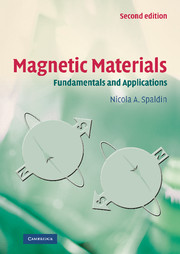12 - Nanoparticles and thin films
from II - Magnetic phenomena
Published online by Cambridge University Press: 05 June 2012
Summary
“It is hard to be brave,” said Piglet, sniffling slightly, “when you're only a Very Small Animal.”
A. A. Milne, Winnie the PoohMagnetic properties of small particles
The magnetic properties of small particles are dominated by the fact that below a certain critical size a particle contains only one domain. Remember from Chapter 7 that the width of a domain wall depends on the balance between the exchange energy (which prefers a wide wall) and the magnetocrystalline anisotropy energy (which prefers a narrow wall). The balance results in typical domain-wall widths of around 1000 Å. So, qualitatively, we might guess that if a particle is smaller than around 1000 Å a domain wall won't be able to fit inside it, and a single-domain particle will result!
We can make a better estimate of the size of single-domain particles by looking at the balance between the magnetostatic energy and the domain-wall energy (Fig. 12.1). A single-domain particle (Fig. 12.1(a)) has high magnetostatic energy but no domain-wall energy, whereas a multi-domain particle (Fig. 12.1(b)) has lower magnetostatic energy but higher domain-wall energy. It turns out that the reduction in magnetostatic energy is proportional to the volume of the particle (i.e. r3, where r is the particle radius), and the increase in the domain-wall energy is proportional to the area of the wall, r2. The magnetostatic and exchange energies depend on particle radius as shown in Fig. 12.2. Below some critical radius, rc, it is energetically unfavorable to form domain walls, and a single-domain particle is formed.
- Type
- Chapter
- Information
- Magnetic MaterialsFundamentals and Applications, pp. 145 - 155Publisher: Cambridge University PressPrint publication year: 2010

